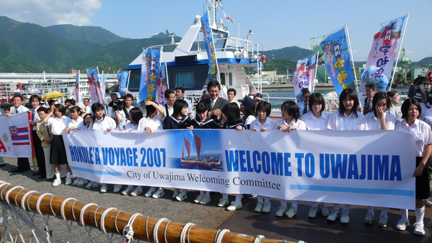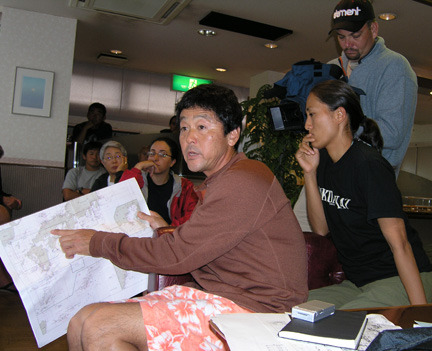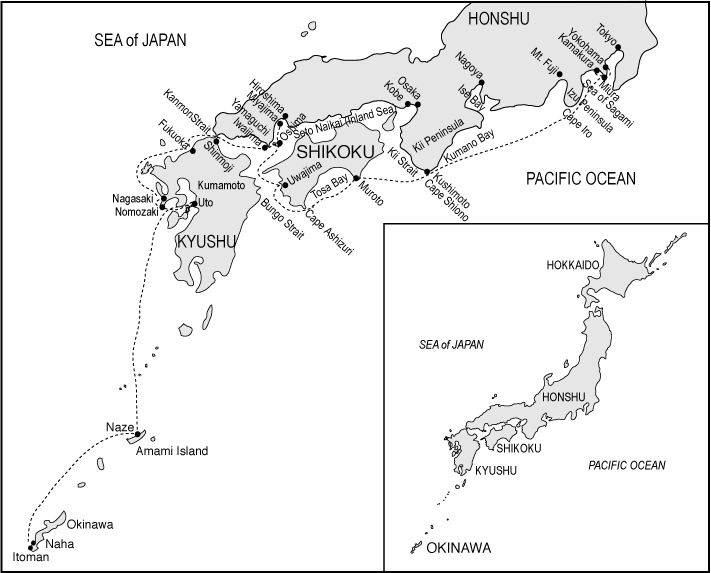Ku Holo Komohana / 2007 Voyage to Japan
Uwajima (May 27-June 4)
May 27-28 to Uwajima
Honolulu, HI – Hokule’a, under captain and navigator Nainoa Thompson, and the escort boat Kama Hele, under captain Mike Taylor, are on their way to Uwajima, Ehime Prefecture today. They left Hiroshima last night, at about 6:30pm Hawai’i time, 1:30pm Japan time. The two vessels stopped at the island of Oshima overnight, to avoid traversing the extremely busy Inland Sea, dotted with tiny islands, in darkness.
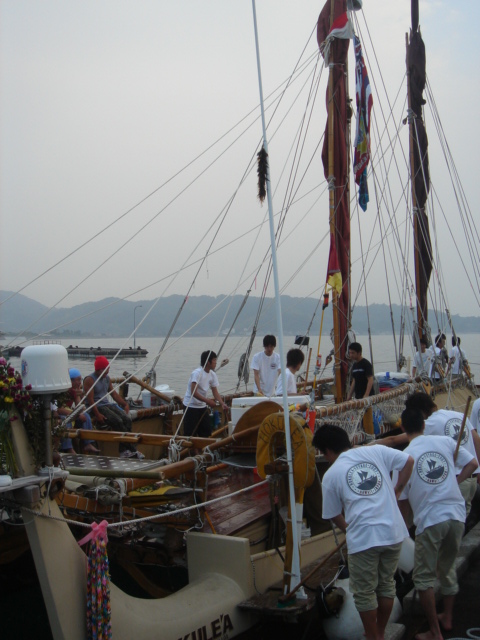
While Hokule'a was in port, students of the Maritime Technology College helped cleaned the canoe. From a weblog at http://blogs.yahoo.co.jp/sweetpotatoyoshi/
They departed Oshima at about 6am Monday, Japan time.
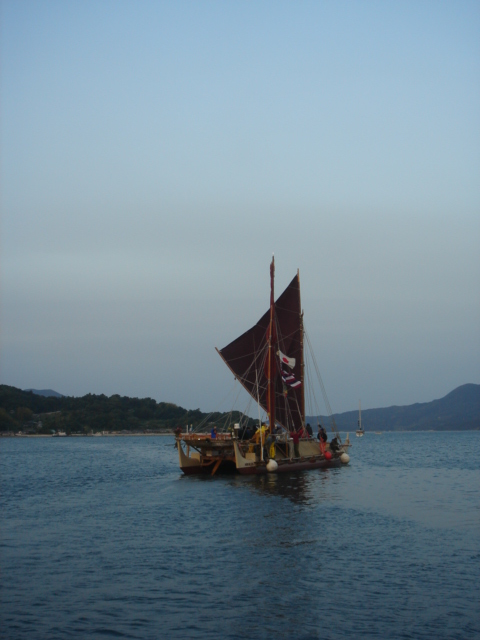
From a weblog at http://blogs.yahoo.co.jp/sweetpotatoyoshi/
This journey will take about 10 hours to reach Uwajima in the southern portion of the island of Shikoku. They should then arrive at about 9pm tonight Hawai’i time, or 4pm Japan time.
On this journey to Uwajima, Ehime prefecture, Hokule’a is carrying 20 crewmembers: Nainoa Thompson, Chadd Paishon, Pomai Bertelmann, Dr. Cherie Shehata, Iolani sophomore Sky Takemoto, Attwood Makanani, Ka’iulani Murphy, Dennis Chun, Nanea Baird, Monte Costa, Kiyoko Ikeda, Taku Araki, Kanako Uchino, Imaikalani Aiu, Stephanie Beeby, Kaimi Hermosura, Keala Kai, Van Warren, Heidi Guth, and Anela Benson.
Uwajima is the homeport of the Ehime Maru, the ship sunk off O’ahu by a U.S. submarine in February 2001 killing 9 crewmembers, including 4 high school students. This stop is particularly poignant because in February of this year, the father of the one student never found, speaking publicly on behalf of the bereaved families, said that when Hokule’a sails to Uwajima, she will carry home the souls of their children.
May 28 arrival at Uwajima
Honolulu, HI – Hokule’a, under captain and navigator Nainoa Thompson, and the escort boat Kama Hele, under captain Mike Taylor, with good wind to fill Hokule’a’s sails, sunshine and calm seas, arrived at Uwajima, Ehime Prefecture at about 9:00pm Hawai’i time last night, about 4pm Japan time. They arrived after a 10 hour crossing from Oshima in the Inland Sea.

From http://blogs.yahoo.co.jp/naoki2805/7611303.html
After an arrival ceremony, the crew of 20 on Hokule’a and 5 on Kama Hele were treated to a welcome reception at the Uwajima City Hall and a dinner with about 400 people.
Greetings at Uwajimas Shin-Nai Pier. Photo by Takashi Ichikura
A giant demon-bull that wards off evil spirits greets the crew. The Bull is one of the symbols of Uwajima city. Photo by Takashi Ichikura.
Today, the crew is participating in a ceremony honoring the 9 victims of the Ehime Maru tragedy more than 6 years ago. Uwajima is the homeport of the Ehime Maru. Six years ago, Hokule’a took flowers from Hawai’i’s community to the memorial site. Earlier this year, on the 6th anniversary, the father of the one student never found, speaking publicly on behalf of the bereaved families, said that when Hokule’a sails to Uwajima, she will carry home the souls of their children.
At this ceremony today, the crew will be giving flowers and gifting to each of the victims’ families a handmade 3-foot tall feather kahili created by Kaleinani Brown, along with a wooded stand for the kahili made by one of the builders of Hawai’iloa, a gifted wood worker who has worked on Hokule’a, Jerry Ongais
In addition, the crew will be conducting workshops at Uwajima’s schools and tomorrow night the crew will be conducting a lecture at the Cultural Hall, which will be followed by a concert by ukulele master Jake Shimabukuro.
There will be a major crew change in Uwajima, for the last leg of this voyage. That 7-day leg will go from Uwajima to Yokohama, with a tentatively scheduled departure date of Friday, June 1st, depending on weather.
May 29: Tour of Uwa Jima ( Shehata)
Today would prove to be a rigorous day to say the least. We had a full action packed agenda and were going to be touring around Uwa Jima.
One of the most important missions however while here would be a visit to the school of the nine children who died tragically aboard the Ehime Maru.
[Note: In February 2001, a tragedy brought Hawai'i and Japan together: Ehime Maru, the training ship for Uwajima Fishery High School, sank off Le‘ahi (Diamond Head), Honolulu, after being rammed by the USS Greeneville, a nuclear submarine performing a rapid ascent maneuver with two civilian guests at the controls. Nine crewmembers of Ehime Maru drowned, including four students. In March 2001, the Hawaiian community came together to help with healing the tragic loss for the families of the drowning victims. Hōkūle‘a participated in a memorial ceremony at Maunalua Bay, east of Le‘ahi, leading a flotilla of mourners, including a vessel with the families on board, to place lei on the spot where the Ehime Maru sank. A spiritual connection was forged between Hōkūle‘a and Uwajima.]
The tragedy occurred 6 years ago, and since then there has been a link between the town of Uwa Jima and Hawaii, to help build bridges and allow for the healing process to conitnue. After the tragedy happened a group from Hawaii wanted to send their deepest regrets that such a tragedy could happen, and had asked anyone who wanted to give a flower to bring it to Hokulea, and that the voyaging canoe would bring those flowers out to sea in remembrance of those 9 children. Apparently the families of those children were so touched by the gesture that they asked when Hokulea sailed to Japan that they also bring the souls of their children back to them.

Ehime Maru Memorial, Kaka'ako Waterfront Park, Honolulu. Students from Saint Louis High School hosting Japanese exchange students from Uwajima Fisheries High School in 2006. Photo from the Honolulu Star Bulletin
Today, we traveled to the school and met the family of the nine children. It probably was one of the hardest things to do. You can still see the pain in each parents eyes, yet the resilience that they are able to exude is unimaginable. Mr. Mizuguchi, the spokesperson for the families, would also be in attendance. They then took us outside in front of the school and showed us a monument for the children. 7 balls stacked on top of each other representing 7 ocean, with 9 surrounding pillars supporting the ball, representing each of the children. We would present to the families kahili made by Kaleinani Brown, and a stand made by Jerry Ongais. Each stand was placed in front of the family one by one, then each kahili one by one was placed into the stand to the families. Each crew member then presented flowers to the memorial. The families expressed their gratitude and stated that they were touched by the gesture that was made.
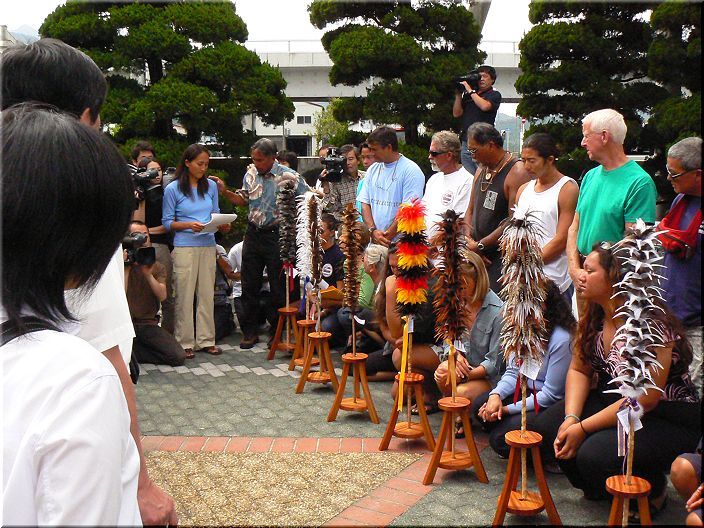
After the ceremony we left the school and headed over to one of the more well known traditions here, bull fighting. Yes, I know it does not seem real, but nothing does seem so here, I am going to watch a bull fight in Japan. Apparently, the story goes that there was a group of Dutch sailors who ran aground in Uwa Jima, and were taken in and cared for by the locals here. Later the sailors returned home to Holland, and sent bulls as gifts to the city for helping them out. Hence, the tradition of bull fighting had been started. I am not sure if some of the story was lost in translation, but that is what I got. The arena was a big round circle, with a huge tent like roof, with colorful benches encircling the central arena. The bulls are made to touch heads and then basically push against each other, in a rather gentle manner. We were told that they just wanted to give us an idea of bull fighting but not go all out. They had set this demonstration just for us that day, usually the event only occurs 5 times per year.

The Bull is one of the symbols of Uwajima city. This statue is in front of Uwajima station. Bullfights are held in the city, a kind of bull sumo. Victory is achieved when one bull chases the other from the ring or forces the opponent to its knees.
After the bullfight, we were whisked away to the Date (pronounced Dahtay) Museum. The was the family name of Uwajimas diamyo (feudal lord). Here we would see the Palanquin that carried Princess Yoshi, a beautiful box with gold detail and a large long rod that extends over the top to carry her around town. There were several samurai uniforms, bows and arrow, masks for plays, and various ceramics. I feel like I should have taken a Japanese Art/History course before coming, there is just so much to see and learn here.
The day continued now, with a visit to Uwa Jima castle. This castle is beautiful, and takes about 20 minutes of climbing up stairs. On your way up you are surrounded by giant trees, which allow bits of light to stream through. The steps are made of stone, with some moss surrounding them. At the top of the steps, there is a grand lawn, with a picturesque view of the city all around. You can see why the samurai would have chosen this spot as place of defense against attack. If any one were to come they would be exhausted by the climb up for sure. Inside the castle, which was three tiers tall, you could see a completely wooden architecture. There were no furniture in it now, but I could imagine how regal it must have been if it were all decked out.
We then traveled on, yes the day still went on. We made it to a pearl farm, and had a demonstration of how pearls are made, and harvested. Then we headed up to the pearl shop, which was just like letting loose children in a candy store.
Finally, we headed back to the hotel, got cleaned up and treated to a dinner by Mr. Mizuguchi. It was a beautiful set up, with tatami mat seating, and a long table full of food fit for a king. There was sashmi overflowing the platter, vegetables, soups, fried chicken, katsu and fresh fruits. It was a truly nice way to end a beautiful day.
May 31-June 2: Events in Uwajima (Shehata)
In the past few days I have seen some wonderful and unusual things. Today however, may have taken the cake so to speak. We had a pretty easy day here at Uwajima. Tonight we would attend a concert to celebrate the full moon, and the arrival of Hokule’a. This concert would take place up in the mountains, in this secluded forest. The forest was absolutely beautiful, with tall trees all around. There is a large cabin to the left on the hill, just in front of the main road. To the right you see a sign, it says don’t feed the monkeys (actually it had a cute cartoon drawing of a monkey, with a big X on it). Then there were steps made of stone that zig zagged down to the camp sight slash concert area. Before he camp sight there was a bridges that crossed this beautiful river, with boulders over 10 feet tall and wide.
As you continued down you could walk up to the camp/concert area, or go down to the left where there was a short walking path. Heidi, Kaiulani and I decided to go exploring down the path to the right. This path followed the river for the most part, and was really breath taking. As the sunset we headed over to the concert area. Now this was very interesting, even Kana and her Japanese friends had not seen anything like this before. It was more new age to them. There were a series of performances on a beautiful wooden stage, with the mountains and other cabins as the backdrop. The first performance was some singing and dancing. As it got dark, you heard the beat of taiko drums, and then on a separate stage you saw fire dancing. Some were twirling sticks of flames, other rings of flame. There were different types of singers, some folk. There was even a lady playing a xylophone, and wailing/singing at the same time, some improv melodic tune. They had provided us with home cooked meals, and pizza.
That night also happened to be Kana’s birthday. This is the second voyage where I have been with Kana on her birthday. They turned off all the flood lights, lit the candles on her cake, and brought it to the front stage on a kayak. We all sang happy birthday, and she blew out her candles. The MC then presented the cake to her, and actually put her face into it. Poor Kana. She took it rather well and laughed the whole thing off. I’m sure she will chalk this one up to another memorable birthday.
June 1, 2007
This would be a day of exploration and trial and error. Heidi, Imai and I wanted to see a different part of Uwajima. Actually to be more accurate Imai had his lonely planet guide, and also had visited the tourism center and found another place to go. We would try to visit Yakushidani Gorge. This area had well maintained paths, with different rock formations; it was more of a work of art (or nature for that matter). This place is tucked in the mountains, a 30 minute bus ride up from the area we were staying at. Let me tell you it was a challenge to figure out the kanji that matched the place we wanted to go. We found an easy character and used that as the marker to look for on the bus.
The challenge was figuring out where to get off. We figured it should be easy since it was the last stop on the bus route. The bus stops in the middle of road, with no apparent entrance to the gorge in sight. Using sign language we figured it was a walk up the road to the area that we wanted to get to. We find the area, look at the tourist map, written in Japanese, and figure out which route to take on the hike. This place was beyond description. Trees that extend to what seems the sky, steep rock formations, with paths that meander both up and down and side to side. Since the hike was along the river, there was all sorts of bridges that went up and down, and one that even made about a 110 degree angle over to the other side. My favorite water fall was Yukiwa-no-Taki. This waterfall must have been at least about 6 stories high; we were at the base of it where it drained into the pond. The water was not flowing very heavily, but enough to glance over the rocks, and curve down. The water had this sheen, and would come apart into three different sections, and then merge again toward the bottom. To say the least it was a nice relaxing day, and a much needed break.
June 2, 2007
During our stay we would be treated by Mr. Mizuguchi (the spokesperson for the Ehime Maru tragedy) on several occasions. He first treated the entire crew to this magnificent dinner, which was not necessary, but much appreciated. It was by far one of the most laughing I have done in a while. Today he would take a small group of us, with another official serving as our guide, to Shimanto River. This would be about a 30 minute drive from our place in Uwajima. We were told that the Shimanto River was one of the cleanest rivers in Japan. The river has really high river bank walls, but currently is not flowing at full blast since rainy season is just starting. They have two levels of bridges one really really high about 30 feet, and the other about 10 feet above the river surface. The 10 foot bridge is made of cement, one lane wide, and has no guard rails. We were told that they don’t place guard rails because if they did when the river flowed over the bridge, it would just push the whole bridge over. We stopped and spent about 30 min to an hour at the river, walking and soaking in the environment. We then drove to a nearby hotel that was sitting over the river, listened to classical music and sipped tea. Let me tell you I really needed this trip, and it helps put things into perspective. Thank you Mr Mizuguchi for taking the day to spend it with us, it really means a lot to all of us.
May 29
福岡に到着して多忙な日々が続いているが、毎日毎日ホクレアを訪れる人は後を絶たない。福岡入港してから早速、太鼓やフラで大歓迎を受けた。AINAと呼ばれるホクレアのダンスをクルーは披
男性には無い“目”を持っている。星を見て、そして見えない曇りの夜も進路を決める決断をするのが男性で、クルーの気遣いや目指す島をしっかりと把握し続けるのが女性像だという。ホクレアには神様は積んでおらず、TIKIは人間の象徴だ。航海は全て地球と人間、すなわち海と人の共存。この地球上で人間が生活していく社会のモデルをこのホクレアは訴えている。
毎日、大歓迎を受ける我々は海からわたってきた人を笑顔で受け入れる日本人の温かい心を毎日かみ締めながら、親子のワークショップを通じて家族のあり方、学校教育のあり方、そして男性と女性像をできるだけ多くの人とシェアし続ける。一昨日、昨日とプラネタリウムでのワークショップはとても盛り上がった。たまたまここ福岡で出会った高校の生成と意気投合した自分は、チャッドの許可を得て明日の夜、地元高校生の宿泊体験でより具体的なスターナビゲーションの実習を企画した。そして一日のみのフリー時間となった水曜日には、一般向けの乗船体験で再びメッセージをシェアできることになりたくさんの人がホクレアに乗りにきてくれた。どんなに忙しくても毎朝のOC1トレーニングは欠かさない。なんといっても来週末はモロカイチャレンジ。今回10年ぶりに出場を延期したのはこのホクレアのメッセージを日本人に伝える使命を感じたから。
たくさんの人の夢を希望が集まるホクレア号のプロジェクトだが、毎日の天気と同じようにスケジュールは柔軟だ。それがまたユニークで面白い。特にナイノアとチャッドはキャプテンとしてまったく性格が異なる。ナイノアが再び来日するのはまだ先になりそうだが、毎日自分はチャッドのユニークさにはまっている。奄美、長崎、そして福岡とチャッドのナビゲーションは冴え続けている。
5月17日(木)
玄海島を訪問した我々ホクレアクルーは島の人々から大歓迎を受けた。港に駆けつけたたくさんのおじいさん、おばあさん達と一人ひとり握手すると皆「アロハ」と声をかけてくれる。災害後の神社を尋ねると崩れたままになっている石碑が散乱していた。地震後10ヶ月というスピードで崩れた斜面を復興し、集合住宅、個人住宅、公園、非難道と島民全員が一つになって新しい島の復興を目指している。子供たちが島の歌を我々にプレゼントしてくれた。
「島に咲いた小さなつぼみが再び戻ってきた。ここで暮らしていこう。島中に夢を咲かそう。」
「坂道を駆け上がる小さな元気な鳥たち。太陽を体に感じて飛び立とう。」
島民500人という漁民の島。それにしてもこの一致団結力は今の日本で珍しいのではないかとさえ思う。子供たちの歌声は深く胸に響いた。彼らこそが未来でありホクレアが与える夢。子供たちから手つくりのしおりや扇子を受け取った。これはこの航海でずっと読み続けた宮元武蔵の本に差し込んだ。もうすぐ関門海峡を通過する。今朝のミーティングでは潮目となる10時の時点でもっとも流れが激しい場所を通過するという。昨日チャッドや西村さんらパイロット達は実際に海峡を視察した。風は昨日から強く吹き明日の出向は明後日へと延期された。巌流島の横を過ぎるとき、何を追い求め戦い続けたのか、武蔵の魂をホクレアから感じ取りたい。
また昨夜は地元福岡工業高校ラグビー部の宿泊体験を行った。ここ福岡では完全に行政主体の受け入れ態勢がとられているのでなかなか一般の人々との交流が行われにくい。自分はホクレア入港時に出迎えてくれた高校の先生達と意気投合。お互いに海外に挑戦したスポーツ選手だったからまた盛り上がった。県が主催したパーティーで出会った通訳ボランティアの中学校の先生とも話は進んだ。毎晩遅くまで親の了解を得て自分に生徒を紹介してくれる。生徒達からの手紙が何よりも嬉しい。昨夜もできる限りのメッセージを伝えようと夜遅くまで話をした。チャッドはそんな特別企画を大いに喜んでくれる。
「よし、やって来い!後は何とかなる。」
と一言。自分の背中をポンと叩くだけ。沖縄でナイノアが降りた後、次々とスケジュールをこなし、そしていつもはつらつとしているチャッド。彼のナビゲーターとしての存在はまさに日本航海に最適だと思うし、ナイノアはそれをちゃんと知っていて彼を選んだのだろうと思う。ホクレアは常に前に進んでいる。
ホクレアや海人丸に乗った子供たちの目の奥にはいつも何かが光る。その光が自分の心に深く響く。夜11時ごろ、生徒が作ったカレーライスは全て無くなったころ、ホテルにいたチャッドを呼ぶと喜んで降りてきてくれた。
「今までの航海でどんな島が一番印象的でしたか。」
という質問にチャッドは答えた。
「全ての島が特別だ。でも特に日本は特別。カリフォルニア程度のスペースしかない国の都市部に多くの人間が集中して住んでいる。一分一秒で全ての交通機関が動き人はそれに頼り仕事をしている。この不安定なバランスはいつか壊れてしまうのではないかと危険を感じる。その反面、地方の人々は海から来た人間を受け入れる寛大な心を持っている。手作りの野菜と取れたての魚を出してくれる。まさにアロハだ。」
「嵐のときどうやって自分をコントロールするのですか?」
「チャッド船長の夢って何ですか?」
次々と質問が飛び出してくる。チャッドが答えた言葉はこれまで聞いてきた言葉の何よりも強く自分を揺さぶった。エディが行ってしまったとき、チャッドは陸にいた。ナビゲーターになる夢を追い続けて32年間、ようやく今年ポウの儀式を経験した5人の一人になった。雑草のような人生だったと彼は語った。自分の今までの人生とチャッドの行き方に限りなく似た波長を感じた。いまでも彼の言葉が脳裏に強く響く。10人のラグビー選手達が同じ場所にいてくれたことを感謝している。ホクレアのニュースを聞いて駆けつける地元の方々は日に日に増える。純粋なホクレアの支援者が言ってくれるこの言葉が嬉しい。これは文字では通じない。頭では絶対に理解できないメッセージです。自分の声で、そしてカヌーに触れることでしか伝えることができないもの。それはホクレアに触れたあなた達が感じてくれる何か。チャッドが自分に言ってくれた言葉を胸が詰まりそうになりながらも全力で伝えた。このホクレアの日本航海。それは間違いなく二つに分けられる。一つはホクレアが生まれエディが消えた頃から沖縄までの冒険。もう一つが曳航航海をしてまでも日本の地方と都市を訪問しメッセージをシェアすること。この福岡でようやくそれが明確に自分の頭の中で整理された。連日カナの助けをかりながらホクレアの訪問客と繋がろうと努力している。ナイノアからそしてチャッドから学んだことを自分の言葉で伝えたい。日本は生まれ変わると感じている。航海を続けたどり着いた場所でメッセージを伝える。人は皆漕ぎ続ければいつか自然とその場所に立っている。今日もまたホクレアの上で新しい出会いがある。家族は確実に増え続けている。
KEEP PADDLING. 荒木汰久治
5月14日(月)祝島寄航
午前1時。忙しかった福岡を出発した。我々が向かったのは山口県祝島。橋が架かっていない700人の島人全員が。船の上に乗った小学生の元気な歌声で大歓迎を受けた。櫂伝馬と呼ばれる昔の漁船を漕ぎ出す漁師達は広島から“平和の火”をランタンに入れて届けてくれた。4年に一度しか踊らないという伝統的な踊りを我々ホクレア来航に合わせて特別に披露。パドルを持ち小さな樽(台)の上でするどく体を回す踊りで見ているだけでも難しそう。体の軸に力を入れないと鋭い回転はできない。しかも揺れる船の上でバランスを取るのだからこれも大変なことだ。
一昨日福岡の北九州市のプラネタリウムで行った親子セミナーの会場に一人の祝島の男性と出会った。彼は祝島でもっとも若い農業従事者。彼は自分の島にホクレアを呼ぶ為にやってきた。原子力発電所建設計画を背後に過疎化が進む現実と向き合って必死に生きている。チャッドは二言返事で祝島に寄ると返事した。当然寄港地を増やすということは到着する山口州防大島での歓迎式に間に合うかどうか、日本受け入れ体制を統率するハワイ州政府観光局の方は心配だ。チャッドは「なんとかなるさ。」と一言。確かにスケジュールは遅れ受け入れの方々にはストレスを与えることだろう。しかしこのホクレアが日本に残すものは“夢”だとチャッドは常に言っている。自分も全く同感している。予定外の寄港地の選択にも柔軟に対応できるのもナビゲーターとしての資格だと感じている自分、鯛の刺身とびわの差し入れは最高だった。この祝島寄航の意義は大変深かったのではないだろうか。そのまま目的地を目指す我々は洋上で静かな一時を過ごしている。
汰久治
5月23日(水)
洲防大島
山口県洲防大島に到着した。大島商船高校で歓迎を受け、続いて2千人を越える島人の大歓迎を受けながら入港した。チャッドのナビゲーションはここまで。連日ホクレア乗船体験会には人が押し寄せる。2日間の停泊期間だったができる限り多くの人にホクレアに触れてもらい、そして自分の口でメッセージを伝え続けた。毎回寄港地で乗船体験を受け持つ自分は焼く30人をグループとして約7~8回に分けておよそ250人の人間に対しできる限りのメッセージを伝える。それは自分がホクレアのクルーとして沖縄以降も乗り続ける理由だ。洲防大島の深い森は透き通るように澄んだ夜空を我々にプレゼントしてくれた。どこを見ても星が無数に広がる。島民の半数以上が50歳以上という高年齢の島だがおじいさん、おばあさん方の嬉しそうな顔が忘れられない。自分は常に自分とホクレアの出会いをホクレア乗船した人に話している。なぜ自分がホクレアのクルーになりたいと思ったのか。それはエディの見た世界を見たかったから。彼のホクレアに懸けた思いを感じたかったからだ。どうしたら自分の大切な人間を助けることができるのか?どうしたら自分の限界の裏側を見ることができるのか?そしてどうしたら自分の未来を見つけることができるのか?それがただ純粋に知りたいと思った。
そしてそれは自分が始めて挑んだモロカイ世界選手権のゴール後に偶然出会ったジェイクの教えだった。「お前はなぜ強くなりたいのか?お前の求める強さとは何か?」それまで自分が求めていたのは“世界一”とか“日本一”という肩書きであり、人間がたどり着く究極の世界は自分の命と向き合うことだということを教えられた。乗船会に参加された人から受ける質問の中で最も多いのは「どうしたらホクレアのクルーになれますか。」ということ。その度に「9年間ハワイに通い続ければ叶うかもしれませんね。」と笑いながら答える。でも本当の自分の答えは「なぜホクレアのクルーになりたいのですか?」ということ。その質問は自分が9年前にジェイクからもらった言葉に限りなく近い。表面を求めていた自分に彼が見せてくれた世界がエディだった。自分は今、エディの代わりに日本人へ伝えたい。
「皆さんはなぜホクレアに憧れるのですか?」「なぜホクレアに魅せられるのですか?」
自分はホクレア号の歴史の初代クルーだったエディ達が挑んだ航海にいつも憧れている。だからヤップ島から沖縄を目指すとき曳航に頼らないとナイノアが言ったとき自分の夢は叶ったと思った。それは自分が求めていたのは我々の祖先が海に漕ぎ出したす瞬間の気持ちを実体験したかったからだった。それはエディが求めた世界でありナイノアが今でも子供たちに語り続けるストーリーだから。自分の夢はその領域に自分を置くことであり、それは自分の肉眼で日本という島を見つけることでもあった。自分の体内に電気が走り、それが大きな波となって首筋を越えたとき感動の涙があふれ出た。その波長は一回では終わらなかった。何度も何度も繰り返しやってくる。幻想なのか現実なのかまさに命の波動を感じた。それは間違いなく祖先と繋がる瞬間だった。エディが求めた世界でありナイノアがブルースがそしてジェイクが自分に見せてくれる世界だ。そしてこれが自分が日本の子供たちへ伝えたい世界。全ては現実に起こったこと。歴史とは実際に起こったこと。人は歴史を学びそして未来へと歩いていく。
ここ山口でもホクレア寄港のニュースは新聞に取り上げられる。しかしどの記事を見てもホクレアの話題以外は悲しい事件や問題が多く取り上げられている。久しぶりに新聞を読んだが一体日本はどこに向かっているのだろうと不安になってしまう。争うこと、ぶつかること意外で問題を解決する方法があるとしたらそれは海を渡ることだと自分は信じている。複雑化した社会をシンプルにする方法もまた、海を渡ることで解決されるのではないだろうか。商船高校の学生がたまたまデッキ掃除をしてくれた。自分は彼らが福岡工業高校に続く子供達だと直観で感じた。2回目の宿泊体験はチャッドからナイノアへバトンタッチされ子供たちの質問は重みを増す。多くの質問の内一つを選ぶとしたら「絶望した瞬間はありますか?」という質問。ナイノアは過去の辛い歴史を乗り越えたからこそ今があると答えた。そして間違いから学びそれを繰り返さないことが大切だと答えた。人間は間違いを犯す。そしてそれから学ぶ。自分の人生もまたその連続だった。そして今自分は未来に向かって歩こうとしている。沖縄で日本を見つけ、ホクレアのクルーでそしてモロカイを渡ることでエディの見た世界を見た。そして自分の祖先が武士であったことを熊本で発見し、切腹を覚悟で生きた武士のように、挑戦し続ける人生が自分自身だということが分かった。見えない島を目指す。自分を信じる。クルーをそしてカヌーを思いやること。
そしてこれからも航海を続ける。そして家族と繋がりたい。
ホクレアに乗った人々は頭では分からない何かを感じてくれたはず。ホクレアに触れた人は心が揺さぶられたはず。自分が伝えたい感動とはまさに“感じること”、“動くこと”そのためには恐怖を乗り越える勇気が必要だ。
「人間の一番の敵は“恐怖”だ。その恐怖を乗り越えるためには夢が必要だ。大きすぎる夢であればあるほどそれは勇気となって恐怖を乗り越えられるだろう。」
「今日ホクレアに乗って夜空を見ながら夢を抱け。そして明日の朝目覚めたときに、夢は勇気となって君たちを後押ししてくれるだろう。」
チャッドは答えた。それはハワイアンの誇りを取り戻すという偉大な夢を持っていた。
「限界の瞬間こそが、自分が新しい領域に踏み入れる瞬間であるということ。その領域こそがもっとも楽しい瞬間でありそのために生きている。」
ナイノアは答えた。人は海に漕ぎ出し嵐を経験してこそ自分の限界を乗り越える瞬間を知るということが分かった。
“BIG DREAM PROJECT”とチャッドが名づけたホクレア上船体験会。これは間違いなく日本を変える。
今ホクレアは愛媛まで来た。今晩はえひめ丸の生徒達が宿泊体験する。困難を乗り越える勇気、偉大な夢を抱く日となる。
荒木汰久治
Peace Bell, Uwajima, May 31, 2007
A Buddhist priest from Taihei temple presented Hokule'a with a miniature Peace Bell today. The bell is a replica of one housed in the temple, a copy of which was given to the United Nations. Miniatures of the bell were given to John F. Kennedy and Nikita Khruschev during the Cuban Missile crisis to urge them to bring their dispute to a peaceful resolution. Nainoa was asked to ring the bell when Hokule'a arrives in Yokohama. The group "Prayers for Peace" felt Hokule'a was an important symbol of peace for her work in healing the tragedy of the sinking of the Ehime Maru. The text of the letter read at the presentation of the "Peace Bell" to Hokule'a has been translated by crew member Kyoko Ikeda and is posted in the weblog.
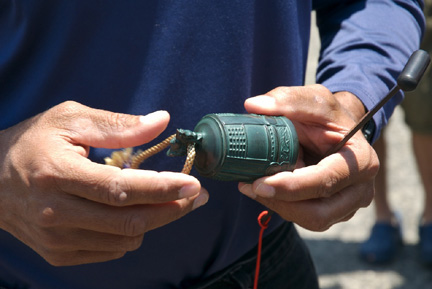
Last night (5/30) navigators Nainoa Thompson and Chadd Paishon and crew members Kanako Uchino and Taku Araki shared with an audience of about 300 the history of Hokule'a and the current voyages of Hokule'a and Alignano Maisu to Micronesia, and Hokule'a to Japan. Ukulele artist Jake Shimabukuro performed a special tribute in song to the drowning vicitms of the Ehime Maru sinking.
Nainoa closed the evening with a vision that Hokule'a continues to be a symbol of hope and a bridge between cultures and thanked the audience for their generous hospitality and aloha for the crew throughout the voyage to Japan and for sharing so much of their traditional culture as an inspiration to bring back to Hawai'i with us. Hokule'a plans to depart at 6 a.m., June 2 JST (June 1 HST) for its next major stop at Yokohama. It may make one or two stops along the way to time its arrival in Yokohama for June 8 HST (June 9 JST).
June 1 Peace Bell presentation speech
Firstly, I would like to extend my heartfelt welcome to all of the 38 crew members of the Hokule’a and Captain Thompson. We, citizens of Uwajima, deeply appreciate your sympathy for the 9 victims of the Ehime Maru accident, and the prayers given at the memorial to console the souls of the victims and their family members.
We kindly ask you to spare your precious time with us and allow us to present this Peace Bell to you.
Uwajima city passed a legislation in 1971 which declares itself as a city dedicated for peace. This declaration of peace was engraved on a monument which is now located right in front of our city hall. The mayor at that time (early 1950's) came up with the idea of collecting coins from countries around the world and melding them into a hanging temple bell in the hopes of creating a symbol for a more peaceful world.
This “Peace Bell” was donated to the United Nations, and was received by then Secretary-General of the United Nations, Mr. U Thant.
Taihei Temple in Uwajima houses a bell that became a model for the “Peace Bell”.
Several miniature copies of the “Peace Bell” have been made using the same metal, and one was given to the chairman Khruschev and another to President John F. Kennedy in the midst of the Cuban crisis as a call for peace.
One of the miniature bells had been in my personal keeping for a long time; however, I asked our mayor to keep it as it would better serve as a symbol for peace in an increasingly violent world. So in the most recent past, this bell was kept by Mayor Ishibashi.
Upon learning about the Hokule’a’s arrival in Uwajima and its mission for world peace, I thought that it would be more meaningful if the bell was given to the Hokule’a. And the mayor full-heartedly agreed with my suggestion.
I would like to present this Peace Bell to you, Mr. Captain, in the hopes of deepening friendship and exchange between Japan and Hawaii as well as preventing tragedy in the future. Also, I hope the Peace Bell will serve as a way to remember how we have together overcome the tragedy of the Ehime Maru accident and to remember our hopes for a safer and more peaceful world.
I heard that the Hokule’a will be heading for Yokohama after Uwajima. This route is exactly the same path that the Peace Bell traveled to get to the United Nations.
I wish you a safe journey.
Lastly, I would like to conclude my speech by mentioning my personal connection to the accident. One of the survivors of the accident was living in our welfare facility at the time of the accident. I still remember about the tragic day vividly, and my heart wrenches in pain as I think of those who died in the accident.
Uwajima Kosei Kyokai (social welfare corporation)
Toyoshige TANIMATSU
Members of the Heiwa wo Inoru Kai (Prayers for Peace)
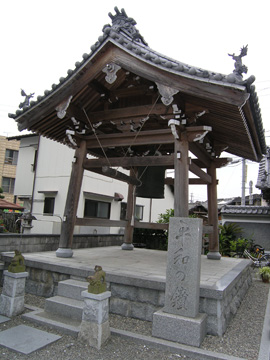
The original Peace Bell at Taihei Temple in Uwajima. The crew visited the temple before departing.
May 31 sharing Hokule'a, Uwajima
Last night six high school students and their teacher slept on board Hokule'a. Under a full moon and a clear night sky, crew member Taku Araki gave them a lesson in basic navigation and Nainoa Thompson, assisted by Japanese speaking crew member Kyoko Ikeda, followed with a more in-depth lesson. The students and teacher stayed up for most of the night watching the stars move across the sky. In the morning, the teacher told Taku, Kyoko, and the students that he had taught astronomy for years but the stars were never more real to him than last night. He told the students, "Let's learn together." Taku and Kyoko said the students were in shock because in Japan teachers are usually placed high above the students as authorities and dispensers of knowledge, so for this teacher to place himself as a learner with the students was astonishing.

Taku and students
Today (5/31 JST), under clear blue summery skies and a light cool north wind, the crew presented Hokule'a to the Uwajima community at Shinnai Pier. Tonight, some high school students are sleeping on the canoe with crew member chaperones. Other crew members are attending a kanikapila (let's play music) with Japanese musicians who met on the internet while following the voyage of Hokule'a. They decided to come to Uwajima and meet the canoe and crew. They slept overnight with the canoe watch and made lunch for the crew today.
Taku's Big Dream Project / Kyoko Ikeda
A Japanese crew member Takuji Araki has been concerned about the state of his country. Every year, over 30,000 people commit a suicide in Japan, devoid of hopes and dreams for the future. Takuji believes that dream is what will save the lives of children and the future of his country. And education is a key in bringing about change in the Japanese society. It is in this hope that Takuji started a program with the support of captains of the Hokule’a to have students and teachers stay overnight on the canoe.
At each port, Takuji hosts a maximum of 10 students and teachers to spend overnight on the canoe. While onboard the canoe, participants learn about life at sea on the Hokule’a and the basics of star navigation. In the past, Captain Chad Babayan and Nainoa Thompson joined Takuji and shared with participants their knowledge on star-navigation as well as their wisdom gained in their experience in sailing on the voyaging canoes. Takuji recalls what Captain Babayan said to a group of students in Fukuoka: “Our biggest enemy is fear. And in order to overcome fear, you need a dream. A big dream will turn into courage that will then help you overcome your fear. Tonight, you sleep on the Hokule’a and think about your dream under the vast sky. In the morning, the dream will have turned into courage to push you forward.” This is how the program was given the name: “Big Dream Project”.
Takuji never fails to mention the story of Eddie Aikau, his hero, and the reason why he became the crew member of the Hokule’a. By sharing the story of Eddie and himself, he is sharing his dream and the power of dream in guiding one’s life and navigating difficult time. In the eyes of students, Takuji is a living example of someone pursuing a dream, a dream big and daring enough to overcome fear.
After talk-story time, participants go to an assigned bunk, to dream about a dream big enough to push them forward. And in the darkness and stillness of the night on the canoe, students and teachers come in contact with the essence of the Hokule’a.
Next morning, students wake up to the crisp air of early morning. One cannot help noticing a renewed sense of being in the façade of sleepy faces. Something must have been born in the darkness of the night. Students disembark the canoe with a spark in their eyes.
What Hokule’a is about is not something to be explained, but to be felt. The power and stories of the Hokule’a are universal at its core and seem to have the power to transcend cultural boundaries. Tears and spark in the eyes of students and teachers attest to the universal values of the message that the Hokule’a carries and the legacy of the 2007 voyage will live on in the hearts of those who came in contact with the essence of her and will ripple across our country.
Comments: Bradda Lou: AAAAHHH, Mahalo nui, for your story of the big dream project, yes the Hokule'a has great healing mana to share with everyone and anyone who comes to her. The souls that are encased within her hulls are there to guide and protect her journeys, and now another journey is about to come to a close and along the way many lives have been touch and, yes changed forever. We the members of the wa'a Kamakura will continue in this healing tradition to build the big dream of Tiger Espere and to secure a cultural and loving relationship that was establish since his coming in 1998. The children of Japan are being exposed to many distraction as we are now living in a high tech age they are forgeting about the life of our kupuna (elder) and the simple things that create a healtier way of life for the survival of this earth that we all share. We thank and bless all the crew of Hokule'a for the inspiration for our group Kamakura Kama O Kala to make Tiger's Big Dream come true. A Pai, A Pai, A Pai Kalanakila Ka Hokule'a!
Aloha Kyoko, Mahalo nui for your retelling of the story of Taku and his dream with the students. It brings to mind what we are also trying to do here in Hawaii. It has been a wonderful and eye-opening experience to have sailed with you, Taku, and Kana during my too short stay there in Japan. This exchange of culture, ideas, dreams, and hopes will only further our collective vision for the future. The strengthening of our cultures will only strengthen world humanity. E holomua kakou a hui hou aku me ke aloha. Malama pono Dennis.
June 1: farewell dinner, hosted by Mr. Mizuguchi, spokesperson for Uwajima families who lost members in the Ehime Maru tragedy.
At the end of the dinner, crew members spoke about their experiences of Japan. Many mentioned that their views of Japan had changed dramatically. Most had thought of Japan as Tokyo, big cities and industries. The voyage introduced them to small town Japan, where fishing and farming and crafts are still a way of life.
Several mentioned the extraordinary kindness of the people, of how they would take time out from their day to walk crew members to places. Eighteen-year old crew member Nanea Baird said that the two people who he remembered most vividly where the elderly fisherman of Miyajima who went out and caught 27 fish to feed the crew at the welcome party at Hiroshima, and the elderly carpenter of Oshima who fashioned pepeiao for the canoe so that the crew could raise the crab claw sails. He was impressed with these elderly men, because they were living energetic and productive even though they were both over eighty years old.
Earlier, over dinnner one night, Taku spoke about loss of the youth in rural Japan, as they left for the big cities to pursue a more prestigious education, lucrative careers, and modern high-tech diversions. He was worried that the farming and fishing and crafts of rural Japan were being lost as there were no longer young people to carry on these traditional activities. Crew members mentioned that when traditional dances were performed at welcome ceremonies, mnay of the dancers were elderly.
Attwood Makanani also spoke earlier about the connections he saw between Hawai'i's kalo farming and fishing and Japan's rice farming.
He was impressed with the rebuilding of the cities of Nagasaki and Hiroshima after the atomic bombings in 1945. As a member of the Protect Kaho'olawe 'Ohana, he saw this rebuilding as an inspiration for what could been done with Kaho'olawe. If sixty-two years after the war, these two cities were prosperious and growing, why couldn't Kaho'olawe be restored and maintained as a place where traditional Hawaiian culture could be practiced?
He was also impressed with the innovation and creativity of the Japanese people and wanted to bring those values back with him to Hawa'i. He wanted to send his children and grandchildren to study and learn in Japan.
June 1, 2007 awaiting departure for Yokohama
Honolulu, HI – Crewmembers of Hokule’a and the escort boat Kama Hele are awaiting departure from Uwajima, Ehime Prefecture for their final leg of this historic voyage to Japan. Captain Nainoa Thompson says the crew has been working very hard with community and education events so they are taking this day of rest for crewmembers to get centered and refocused for the journey ahead. Also, forecasters say a low pressure system will be passing just south of them, likely bringing gusty winds and rain tomorrow; therefore, they have decided to let the low go by and catch the good weather behind it.
Thompson will be returning along with crewmembers who have been on Hokule’a and Kama Hele at least since Fukuoka, more than two weeks ago. Among the 15 returning: Nainoa Thompson, Iolani sophomore Sky Takemoto, 19-year old Nanea Baird, Anela Benson, Heidi Guth, crewmembers from Kaua’i Dennis Chun, Kaimi Hermosura, Stephanie Beeby, Keala Kai, Van Warren, Imaikalani Aiu, Kama Hele Crewmembers Mike Cunningham and Lee Taylor, who has been on board Kama Hele since the voyage began in January and is the son of Kama Hele Captain Mike Taylor, and Hokule’a volunteers Lita Blankenfeld and Mary Fern, who have worked tirelessly to provision both vessels for the entire voyage. They will be arriving on JAL flight 76 at 6:45 am tomorrow, Saturday, June 2nd.
While the crew waited, the canoe tours continued:
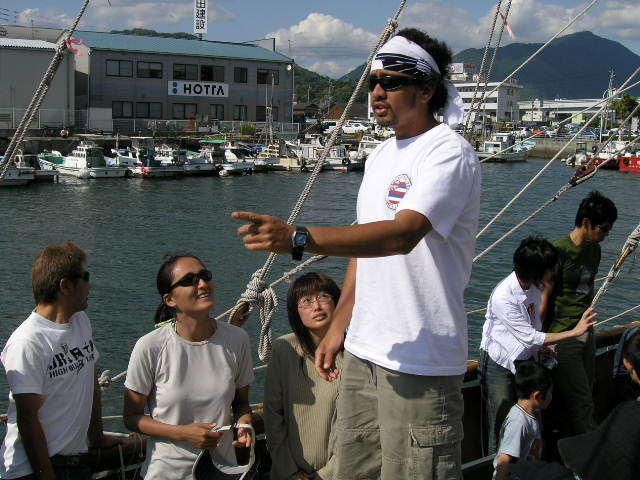
Imaikalani Aiu and Kanako Uchino
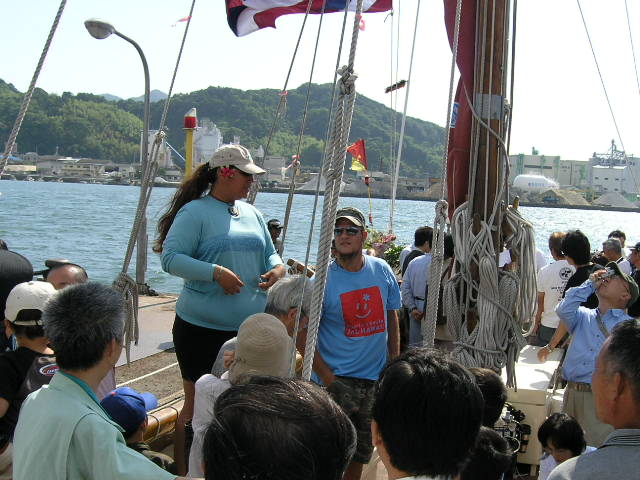
Anela Benson and Sam Monaghan

Chadd Paishon and Pomaikalani Bertelmann

Stephanie Beeby talking with visitors
The 15-member crew sailing Hokule’a from Uwajima to Yokohama has assembled:
Captain/Navigator: Bruce Blanenfeld
Senior Officers: Norman Pi'ianai'a and Tava Taupu
Watch Captain 1 (6-12): Na'alehu Anthony; his watch: Attwood Makanani, Takuji Araki, Patti-Ann Solomon, Chris Baird, Dr. Cherie Shehata, Dennis Kawaharada
Watch Captain 2 (12-6): Ka'iulani Murphy; her watch: Chadd Paishon, Pomaikalani Bertelmann, Leighton Tseu (representing the Royal Order of Kamehameha), Dean Nikaido, Kanako Uchida, Kiyotsugu Yoshida (Sunset Films).
Kama Hele
Captain: Mike Taylor
First Mate and Engineer: Erik Norris
Crew: Sam Monaghan and Kailikepaokamoana Lyman
Escort Consultant: Terry Hee
Pilot with local knowledge: Nishimura-san is the president of Compass Course Ltd. and a representative of Japan at the America's Cup in 2000. His services are provided by NYK Lines in support of the voyage to Japan.
Photographer: Masa Uchida
They journey to Yokohama commemorates King David Kalakaua’s voyage to Yokohama in 1881. It is said he was greeted by a Japanese military band playing Hawai’i Pono’i. The King’s meeting with the Emperor lead to the opening of Japanese immigration to Hawai’i. This final leg of the voyage is expected to take 5 to 6 days, depending on weather.
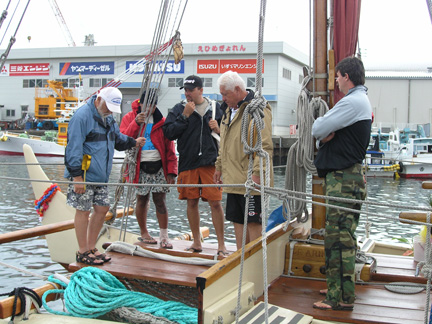
Norman Pi'ianai'a, Tava Taupu, Na'alehu Anthony, Leighton Tseu, Chris Baird.
Pilot Kazuhiro Nishimura goes over the route the passage from Uwajima to Yokohama with the Hokule'a crew.
2007-06-02T03:18:50Z
宇和島に入稿した我々は宇和島水産高校へ訪問。5年前のえひめ丸事故の犠牲になった親族と面会した。福岡で合流したナイノアから
「クルー全員へ遺族に遺憾の気持ちをどういう形で表現すればいいのか一人ひとりが考えてほしい。えひめ丸事故の遺族はホクレアが子供、先生達の魂を運んできてくれる。と思ってくれている。だからこそ我々はその対応の仕方を真剣に考えなくてはい
けない。」
と言葉があった。自分はどういう言葉をかけたらいいのか、そして何をすべきか迷っていた。宇和島に到着してすぐに水産高校を訪問した。我々が対面した方の中にはまだ遺体が見つからない生徒の親もいた。校長先生がメディアの方達を部屋の外へ移動するようお願いし、ホクレアクルー全員と遺族関係者のみの面談が始まり自分はとても緊張していた。通訳をするハワイ観光局、市倉さんの震えた声が自分の心に強く響く。海に消えた悲しい命をのせて太平洋を渡ってきたホクレアは本当に遺族の心の痛みを癒すことができるのだろうか。クルーの一人として自分は何ができるのか?ずっと考えていた。祈りを捧げたカリヒ(ハワイ伝統の鳥の羽でできたスタンド)を家族に渡し、記念碑の前で顕花を捧げた。悲しい遺族の方の表情と向き合い握手を交わす
瞬間「彼らの分まで自分が海を渡ります。」と言う言葉が口から出てきた。想像を絶する悲しみに耐え、そして我々と向き合って
くれる遺族の方に心から何かをしたいと思った。そして校長先生にホクレア宿泊体験
のお願いをした。
今の生徒達、そして先生方が彼らの分まで海を渡ってほしいのです。毎回寄港地で 行っている宿泊体験ですが今回は特別です。是非急だとは思いますが何人でも構いませんので生徒に呼びかけてもらえませんでしょうか。」
「将来的には日本人をハワイでホクレアに乗せたいのです。」校長先生は高校総体県予選大会前日の忙しいスケジュールの中カッター部の先生と生徒を集めてくれた。
昨夜集まった生徒に加え、現えひめ丸の船長、副船長、そして校長先生とホクレアの上にはたくさんの関係者が来てくれた。カレーライスを温めながらナビゲーションやライフスタイルを実体験してもらっていると、地元支援者主催のコンサートに行ったはずのナイノアとブルースが現れた。彼らは宿泊体験の意味を理解しコンサートには行かず自分の行う宿泊体験を応援しにきてくれたのだった。ナイノアにバトンタッチした自分はラッキーにも彼の授業を受ける生徒に戻った。何年も、何年もワイキキの沖で聞き続けたナイノアの話。ついに通訳として日本人へとこの夢のような授業を橋
渡しできる念願の時が来た。話を聞くえひめ丸の子供達。ハワイの子供と全く同じ目の輝きを持っている。子供は世界共通。純粋で素直な心を持っている。ほんの30分だったがナイノアの授業はその場にいる全員を完全にひきつけた。えひめ丸の船長、そして校長先生達とハワイでホクレアに乗せて航海実習をすることで話はさらに盛り上がった。カレーライスを食べながら自分はその後PCを使いさらに詳しい星の授業を継続した。そしてチャッドから受け継いだ“偉大な夢の話”をエディ達が生きた時代、命をかけたホクレアの挑戦時代のことを話た。沖縄を見つけた瞬間の話、先祖の墓に参った話。モロカイに挑む理由も。星の動きを時間をかけて見ながら本当に色んな話をした。気が付くと深夜0時を過ぎていた。
生徒達はキャンバスの中に入り、偉大な夢を抱く時間。自分は少しだけホクレアを離れ友人とマクドナルドでお茶を飲んだ。1時ごろ帰るとまだ一人立っている人がいた。「本当に全てが信じられないくらいシンプルで、しかも考えれば考えるほど奥が深くて、興奮しすぎて眠れません。」引率の先生だった。「今まで自分は何を教えてきたのだろう。知識だけで中身を知らなかった。」
彼の本音は自分の心を大きく貫いた。おそらく日本人の教員全ての人が彼と同じ気持ちなのではないかと思った。日本教育の現状を表す言葉だった。宿泊体験とは特別なにをすることはない。ただ皆で食事をして星の話をして、そして海の怖い話と美しい話をするだけ。でも一晩をホクレアで過ごすということでどれだけ彼らの世界が広がることだろう。偶然にも満月だった昨夜、参加した生徒は移動した星を観察しようと夜中に起きてくる。時間をかけて少しずつ勉強した古人と同じようにホクレアの上では現代人も同じ経験ができるのだ。これは頭で考えたり想像することでは到底たどり着けない感動の世界。
今朝、朝日と共に起きて讃岐うどんを作った。寒さの為よく熟睡できなかったが腹の底から温まり控えめなうどんの味が本当に美味しいと感じた。校長先生も来てくれた。引率の先生が口を開いた。
「先生は昨日からたくさんのことを学びました。まだまだ自分が知らないことがたくさんあるということに気付きました。ホクレアが自分の世界を広げてくれました。みんなもこれからまだまだたくさん勉強して経験してほしいし自分もまだまだ学ばないといけない。一緒にがんばろう。」
その言葉を聞いた生徒の目から一気に涙が溢れ出た。高校先生もそして自分も目頭が熱くなっていた。
生徒の目線で話をする先生。子供と同じ気持ちになって遊ぶ親。大人になってもまだまだ学ぶことはあって常に努力をする生き方。これはアスリートでもサラリーマンでも同じ。ナイノアはいつも言ってくれる。
「自分はマウに比べてほんと小さな経験しかしていない。自分は一生彼の弟子なんだ。でも自分の持つ知識をお前に教えたい。彼が自分に教えてくれたことに対する感謝の気持ちがある。だからお前も次の人へ教えてあげてくれ。」
自分がチャッドへ、そしてナイノアに提案したホクレア宿泊体験実習は、ここ宇和島で確実に形になった。
これが自分にできるえひめ丸へ、そして日本の子供達への精一杯の行動だ。横浜で最後となるこのプログラムに参加する生徒はもう決まっている。彼らのところへと自分はホクレアを運ぶだけだ。新しいクルーを乗せたホクレアはブルースをナビゲーターとして明日の朝6時に出航する。
荒木汰久治
6月2日(土)
ブルースの様態が急変し急遽出航は延期となった。カウアイ島のクルー達と別れを告
げる。昨夜最後の夕食の場で一人一人がこの旅を振り返った。皆ホクレアのクルーに
なれたこと、ファミリーの一員になったことを本当に幸運だと語る。仕事や家庭を離
れ日本に来たクルー達。ここ宇和島から横浜まで乗り込む新しいクルーは正直日本の
ことは知らない。沖縄から山口までハワイ島のチャッド。そして福岡から合流したデ
ニスをはじめとするカウアイクルー。沖縄から九州、中国、四国と旅を続けるハワイ
アン達がほとんど曳航に頼るこの“沿岸航海”から得るものは何か?それは寄港地で
出迎える暖かい歓迎とすばらしい日本文化に触れることだった。日本人の自分でさえ
もまだまだすばらしい日本文化が島々にたくさん残っていることを知り毎日感動の連
続だった。それだけではない。父親はサラリーマンだったため自分が幼い頃から育っ
た環境は常に都市の真ん中だった。喘息とアトピーに悩まされ自然に帰ることを常に
望み続けた自分が、海人丸航海そして今回のホクレアの航海を経て更に日本文化を素
晴らしいと思い、そして都市に住む日本人に伝えなくてはいけないと感じるように
なった。まさに海から陸を眺め発見したことを伝える。今回のそれは間違いなく日本
各地の自然の豊かさだ。出航が一日延期になった今日、市役所の方の案内で四万十川
の上流へとドライブした。山並みの間に瓦屋根が見え、背後に単線電車が走る。透き
通るような水のせせらぎと鶯の鳴き声が見事に調和している。先日は伊達政宗記念資
料館を訪れたが、戦国時代の兜に描かれる見事なデザインに時間を忘れてしまった。
この兜をまとい魂をかけて戦った自分の先祖を誇りに思う。都会で暮らすと全て物が
手に入る。インターネットは一瞬で情報を伝える。ホクレアのソーラーパネルから洋
上でブログをアップすることで、我々の経験する過去の航海を一瞬で陸上に伝えるこ
とができる一方、時間をかけてはぐくまれる大自然の命の営みは、それを肌で感じる
距離に自分を置くこと意外では手に入れることはできない。自分の意志でその場に行
くこと。そしてそこの人々と心の交流を交わすこと。人の心も時間をかけないと理解
は難しい。同じように日本人にとって日本の文化を理解するために、時間をかけて目
の前に広がる光景をまず自分の中に吸収することが必要だと、四国の山並みを見てい
てわかった。乾いたスポンジが水を吸収するように。日本文化はまだまだ我々日本人
が吸収できる素晴らしい。常に歩き回りそして触れ合いながら日本を感じたいと思っ
ている。海人丸の航海は日本を再発見しながら都会を目指す。日本をほとんど知らな
いハワイアンクルーも、もっと奥深く謙虚に日本文化を感じながら学ぶ日本人クルー
も共に海を渡りそして日本と触れ合っている。
ナイノアが昨夜言った。
「TAKU、沖縄に行く途中に見たDVD(ラストサムライ)でお前に言った言葉覚えてい
るか?」
「勿論。自分のサイトの航海日誌にも欠きとめてあるよ。」
と答えると
「愛媛の講演会でもTAKUは何度も行っていたな。ただコツコツとトレーニングを繰り
替えすだけだと。お前を見ていると自分にも武士の血が流れているような気がする。
常にいつになっても上を目指したいと思っている。勝ちとか負けではなく島と島、人
と人をつなげたいんだ。だから漕ぎ続けるんだ。刀をパドルに持ち替え戦(いくさ)
の代わりに海を渡る。」
いよいよホクレアが横浜を目指す。開かれた海の道が見えている。航海は常に続き、
そして海は常に挑戦を求めてくる。
天候の理由で明日も出航は見送られる。4日朝に宇和島を出航し我々は神奈川県横須
賀の城ヶ島を目指す。
荒木汰久治
Uwajima: Returning the Souls / Mike Cunningham
What was it about this person that set her apart from other visitor's for whom I've answered questions about Hokule'a and this voyage, and why had she found me?
As part of the crew of the escort vessel Kamahele, it is rare for me to give canoe tours but on this particular day the crew of both vessels had left for an evening engagement. I was working alone below decks on the Kamahele when I heard someone calling from the dock. I climbed on deck to meet Yuka Inoue and her friend Keiko Imura who had both drive 1-1/2 hours after work to come and see the Hokule'a and asked me if I would take their picture with the canoe in the background
Several inquiries about the canoe during the photo session were the first signs that these individuals were different from the more typical visitor. Questions such as "How long did it take to get to Japan? Did we encounter any storms? How do you like Japan?"-These are the more frequent and common questions asked. Instead, their inquiries spoke to the mission of the Hokule'a, it's intangible power and its presence as a symbol of Hawaiian culture and aloha. Although I knew that I should also be leaving in time to attend the evening crew engagement, I sensed a greater need to share more about the Hokule'a with these individuals who had driven a good distance to see and learn about the canoe.
When I suggested that they actually go on board Hokule'a it was as though I had passed them the Holy Grail and they were overcome with an obvious sense of awe to be on board this legendary vessel.
Yuka went on to say later that she was nearly overcome with "chicken skin" and the feeling that she had stepped onto sacred ground was very powerful when she boarded the canoe. Some of their questions about the Hokule'a were prompted by information they had been reading on the blog everyday since we left Honolulu in January, which clearly underscored their genuine interest in the mission of the Polynesian Voyaging Society, Hokule'a and its many volunteers. As the tour was winding down the discussion turned to the tragedy of the Ehime Maru which sank off the coast of Oahu and 2001 after being struck by a US Navy submarine and took the lives of seven men, most of them maritime high school students on a training voyage from this small city of Uwajima.
Hokule'a and its ohana reached out to the families of the survivors of this accident when they came to Hawaii shortly after the vessel's sinking and took them to the site so that they could conduct a memorial service for their sons. While our government failed to respond appropriately with compassion and respect to these families, the Hawaiian community and especially the Hokulea Ohana reached out with aloha and helped ease the intense grief being experienced by these families so far away from their homes. During the subsequent years the bond between Hokulea and these families has grown stronger due to the yearly family visits to the memorial constructed here in Honolulu to honor these lost seamen.
Yuka appeared to know quite a bit about this unfortunate incident and acknowledged the tremendous symbol of healing and compassion that the Hokulea was bringing to the entire community as well as the fulfillment of a promise made two years ago to sail Hokulea to Uwajima and return the spirits of those lost in Hawaiian waters. I sensed that there might be a deeper connection to that incident that she was not sharing with me at that time. The tour complete I walked away feeling that I had been a facilitator in a spiritual connection between Yuka and Hokule'a and there was a significance to this meeting that I had not yet comprehended.
Later that evening as I left Nainoa's presentation and Jake Shimabukuro's concert, I saw Yuka and Keiko in the lobby and she thanked me again for taking the time to bring her on board Hokule'a and she gave me a note with her phone number and hoped that we would meet again. I called Yuka the following day because I felt that there was something left unresolved during our discussion on board the canoe and we agreed to meet later that evening if I could find my way to the city of Yawatayama. I took the train and was met by Yuka and three of her friends one of whom was an American guy from Wisconsin (Aaron Madalon-Key) teaching English in Japan and the interpreter for the evening. After a great dinner and much conversation about the Hokulea and the voyage of 2007 it was time to return to Uwajima. Due to the late hour (midnight) and the amount of sake consumed (moderate) I chose to stay at a small hotel and take the train back to Uwajima in the morning.
Yuka and her friends arranged for the hotel and asked if I would delay my return the next day until they had an opportunity to show me their village of Ikata, a small picturesque community of 10,000. I agreed and was picked up by Yuka early the next morning and we visited the beautiful countryside and harbor area of Ikata. The dock area was lined with small fishing boats that worked the waters close inshore and also sailed alone west to Korea in search of fish. Her family consisted of five generations of fisherman from this village including her father, uncle and cousin.
Following the harbor tour Yuka pointed to a small community near the top of the steep hillside that boarded the harbor and invited me to meet her family. We drove the very narrow and winding trail to the top of the hillside to a beautiful overlook and then on to her village. After parking we walked through a maze of narrow passageways that ultimately led to her family home. At this time I could not help thinking about the remote and vulnerable situation I found myself in; very little cash, no passport, no luggage, no language skills and a minimum of a 10 mile walk to any type of transportation back to Uwajima (This will be a true test of my Irish charm)
I was graciously greeted by Yuka's mom (Kimiko) and dad (Hirofumi ) along with an uncle and aunt and although we could not communicate well I could sense that my presence there was an important event. Yuka told me that I was the first foreigner that they had ever met and to have me in their home was indeed a special occasion. We all sat on the floor with Yuka acting as interpreter and the discussion immediately turned to the Hokulea, its voyage and the significance of its visit to Uwajima. They had hoped that the canoe could have come to their village and it was at this point I began to realize that there was an important connection between Hokulea's mission to Japan and this family.
Yuka's aunt, Minako Inoue came and knelt before me and began to sob and speak to me in Japanese and after several moments I reached down to comfort her until she regained her composure. I learned that she had lost her only son at sea last October, 2006. Kouichiro had graduated from Uwajima High School 30 years ago and had also sailed to Hawaii on the Ehime Maru (His remains were finally recovered this past March).
Hokulea's mission to return the souls of the young men lost in 2001 also represented an opportunity of hope for Minako to also experience closure to her own sense of loss 5 months ago. However, she was not able to visit Hokule'a in person and had hoped that Yuka would be able to forge this important link by visiting the canoe. I believe that the presence of someone directly connected to the Hokule'a in her home and carrying the powerful message of healing and hope that Hokule'a brings with it on every voyage, was a divine appointment and it was now time for me to have an acute case of chicken skin.
I left Ikata and Yawatayama feeling emotionally drained and also humbled by the events during the past two days. As a Christian I believe that God provides opportunities for us to share the many gifts and talents that we are blessed with among those in need. These opportunities may often appear insignificant but can have a profound impact upon people in need far beyond our understanding.
Now as I witness the steady procession of visitors watching and listening to the Hokule'a crew speak about the canoe and its mission, I realize how important these events are in building the bridges that can one day unite all people of this ocean. I am especially thankful to Yuka and her family for letting me be a conduit for healing and fellowship in their lives and to the Hokule'a Ohana for the opportunity to be a part of this incredible voyage.
June 2-4: Weather Delays
Departure for Yokohama was scheduled for June 1, but a cold front was approaching from the west. The crew waited for it to move east before departing. On June 3, the decision was made to leave at 12 noon on June 4.

